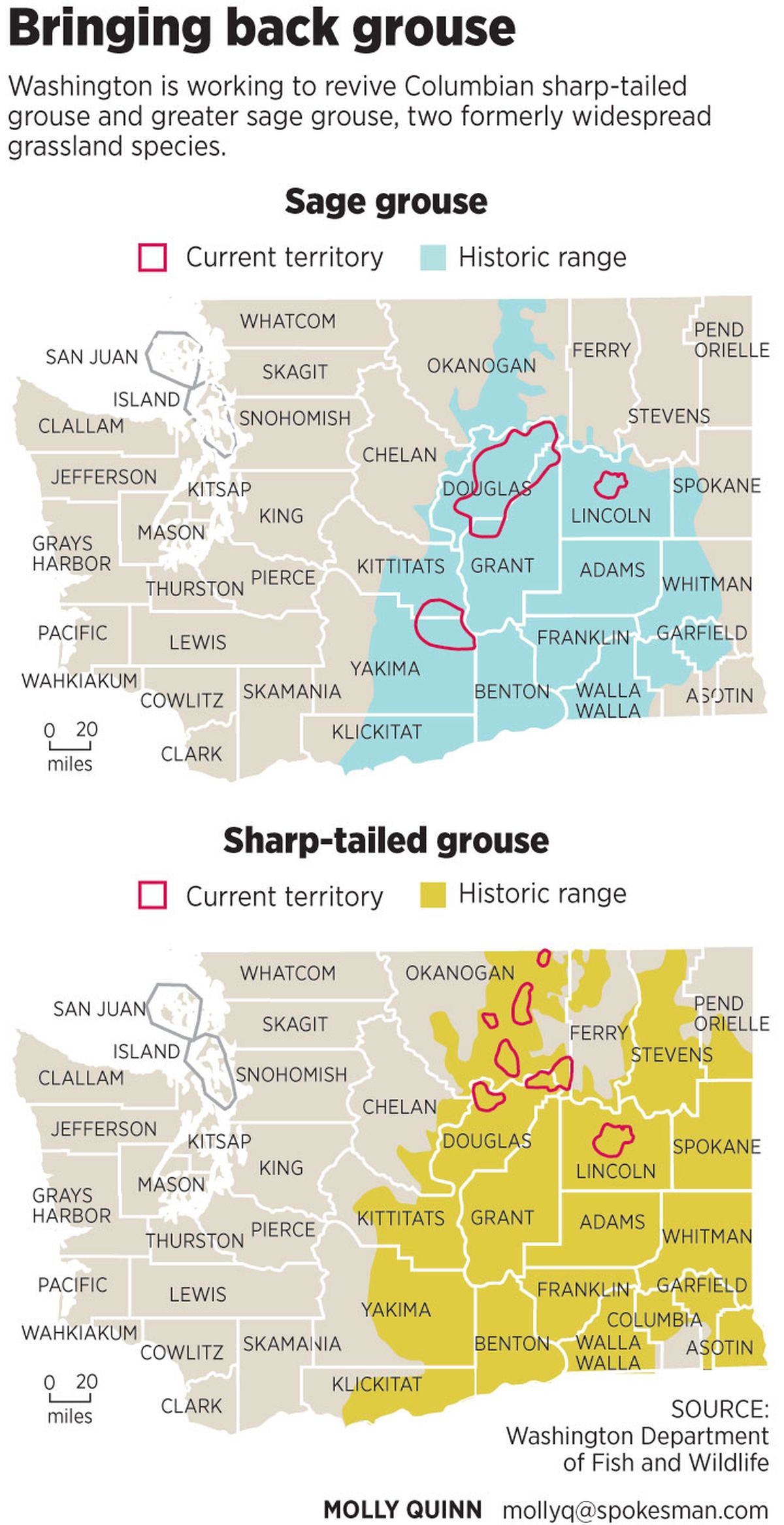Bringing back Washington’s prairie grouse

Prairie grouse, formerly abundant in the sage-steppe regions of Eastern Washington, are slowly improving from the brink of extirpation with the help of other states.
During the grouse breeding period in April, volunteers helped deliver sharp-tailed grouse captured by biologists in Idaho to join their struggling cousins on lonely grass and sage lands in several counties.
About the same time, another shift of volunteers was making the 1,100 round trip to return with greater sage grouse caught in southern Oregon.
The effort delivered 20 male sharptails and 19 females for release over three days at several sites, including the Swanson Lakes Wildlife Area south of Creston.
The birds had been captured with the help of Idaho Fish and Game on private land near Burley, Idaho, and driven 600 miles directly to Washington, where the birds were examined and quickly released to avoid keeping them in cages longer than necessary.
From 2005 to 2012, the Washington Department of Fish and Wildlife and the Colville Confederated Tribes already had translocated 329 Columbian sharp-tailed grouse from Idaho, British Columbia, and Utah.
Last spring, Washington’s total sharptail population was up to roughly 850 birds.
Similarly last month, 20 sage grouse captured in Oregon were transported for release at Swanson Lakes.
Virtually decimated by the mid-1980s, only a few scattered sage grouse were reported in the Lincoln County area before sage grouse translocations began.
“We had to secure more habitat before we could focus on reintroducing the grouse,” said Mike Schroeder, Washington Fish and Wildlife’s grouse specialist.
The 21,000-acre Swanson Lakes Wildlife Area was acquired mostly between 1993 and 1997 with funding from Bonneville Power Administration wildlife mitigation funds to boost threatened species.
The U.S. Bureau of Land Management also was consolidating its holdings into large tracts in the Lincoln County area adjacent or near Swanson Lakes, providing even more habitat insurance for prairie grouse.
From 2008 through 2012, Fish and Wildlife biologists brought in and released 182 greater sage grouse from southern Oregon.
“We had poor survival early,” Schroeder said, but changes in timing and release locations boosted success.
The overall population in Washington, with the largest numbers in Douglas County, was about 1,050 sage grouse in 2012.
At the Scotch Creek Wildlife Area near Omak, the number of male sharptails displaying during spring has grown from a handful in the late 1990s to 50-100 males on three different mating grounds.
Females are more secretive and harder to count.
Swanson Lakes releases have gone fairly well, although fires blackened thousands of acres of habitat last year. The grasslands preferred by sharptails will recover faster than the sagebrush areas preferred by sage grouse.
“These grouse evolved with fires, but they can pose short-term setbacks,” Schroeder said. “Bringing back grouse is a long-term project. Translocations will continue for decades.”
Both Idaho and Oregon have been helpful in providing surplus prairie grouse to Washington. State wildlife biologists as well as many ranchers cooperate because keeping populations strong in several states helps prevent the federal government from stepping in with regional endangered species protections.
“Other states also have benefitted from Idaho,” Schroeder said. “They have a hunted population that’s fairly healthy. Their birds are largely dependent on funding from two federal Farm Bill programs, the Conservation Reserve Program and State Acres for Wildlife Enhancement program.”
This year’s new birds from Idaho and Oregon should help invigorate Washington’s grouse genetically and behaviorally so they can take advantage of habitats that have been improved since the birds went into decline, he said.
This spring he documented 19 male sage grouse on one mating ground – biologists call it a lek – at Swanson Lakes.
“That’s very good considering there were no birds in that wildlife area four years ago. Now it’s one of the biggest groups in Washington,” he said, estimating the total Lincoln County sage grouse population at nearly 50 birds.
Sage grouse have one or two known leks at Swanson Lakes and sharptails have about seven leks, he said.
Statewide, sage grouse have about 27 leks and sharptails about 40.
That’s a long way from the clouds of prairie grouse that greeted homesteaders settling the region in the 1800s, from the foothills of the Blue Mountains in Asotin County northward through the sage-steppe lands of the Okanogan Valley.
But it’s a restart.